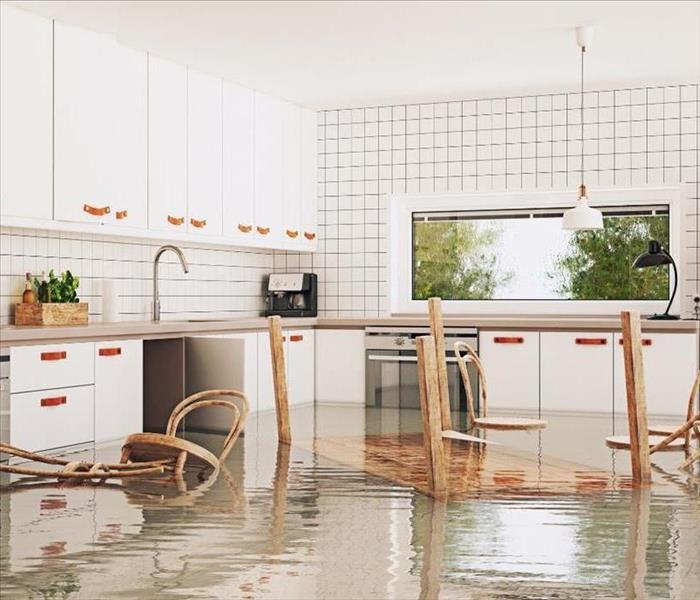Effective Solutions on How to Remove Water from a Flooded Room
9/10/2024 (Permalink)
Flooded rooms are a common and stressful problem that many homeowners face, especially during heavy rains or when plumbing issues arise. You should handle the issue quickly to minimize damage and prevent long-term problems such as mold growth or structural issues. We'll explore how to remove water from a flooded room successfully. Understanding these steps can help mitigate Weymouth water damage or solve similar problems wherever your home is located.
Immediate Steps to Take After Discovering a Flooded Room
Discovering a flooded room can be overwhelming, but taking immediate action is necessary. Here's what you need to do right away:
- Ensure Safety First: Before doing anything else, make sure the area is safe. Turn off the electricity in the affected area to prevent electrical shocks. It's also wise to wear protective gear such as rubber boots and gloves to protect yourself from contaminated water, which may contain harmful substances.
- Stop the Source of Water: Identifying and stopping the source of flooding is the next crucial step. If the flooding is due to a burst pipe, locate the main water shutoff valve and turn it off immediately. If the flooding is due to natural causes like heavy rain, try to block any additional water from entering the room, such as using sandbags or other barriers.
How to Remove Water from a Flooded Room
Once the immediate dangers are tackled, the next step is to remove the water. Depending on the severity of the flooding, different methods can be used:
Manual Water Removal Techniques
For minor flooding, manual methods like using buckets, mops, and towels can be successful. Start by scooping up as much water as possible with buckets, then use mops and towels to soak up the remaining water. This method is time-consuming but can be effective for small-scale flooding.
Using a Wet/Dry Vacuum
A wet/dry vacuum is a powerful tool that can help remove standing water quickly. These vacuums are designed to handle both wet and dry debris, making them ideal for small to moderate flooding situations. Simply move the vacuum hose over the flooded area to suck up the water, emptying the vacuum as needed.
Pumping Out Water
For larger volumes of water, using a sump pump or calling in professional water extraction services may be necessary. Sump pumps are particularly useful for severe flooding as they can remove large amounts of water quickly.
Drying and Dehumidifying the Area
After the water is removed, it's crucial to thoroughly dry and dehumidify the area to prevent further damage. Not fully drying out the space can lead to serious problems, such as mold growth and structural damage. Mold can develop within 24-48 hours in damp environments, posing health risks and further damaging your property. To speed up the drying process, use fans, dehumidifiers, and heaters. Place fans around the room to promote air circulation and use dehumidifiers to remove excess moisture from the air. For particularly damp areas, consider using heaters to help evaporate water. This combination of tools will help ensure the space is completely dry and safe.
Assessing and Repairing Damage
Once the area is dry, it's important to assess the extent of the damage:
- Check for Structural Damage: Inspect the floors, walls, and furniture for any signs of damage. Look for warping, staining, or other indications that the materials have been compromised. Pay special attention to wooden structures, as water can weaken wood over time.
- Consider Professional Help: If the damage is extensive, or if you notice issues that could lead to long-term problems, it's wise to call in professionals. Water damage restoration experts can assess the situation more thoroughly and provide the necessary repairs to restore your home to its pre-flood condition.
Tips on How to Prepare for Flooding
Preparing for potential flooding is essential to protect your home from future water damage. There are several steps you can take to prepare for flooding and minimize the risk of future incidents:
- Ensure Proper Drainage: Proper drainage around your property is crucial to prevent water from pooling near your home’s foundation. Regularly inspect and clean gutters and downspouts to ensure they are clear of debris. Make sure the ground around your home slopes away from the foundation so that water naturally flows away.
- Seal Cracks and Openings: Inspect your home's foundation, walls, and windows for any cracks or openings that could allow water to seep in during a flood. Seal these gaps with waterproof caulking or other appropriate materials to create a barrier against water intrusion.
- Elevate Appliances and Electrical Systems: If you live in a flood-prone area, consider elevating your major appliances, such as your washer, dryer, and furnace, off the ground. In addition, electrical outlets, switches, and circuit breakers should be installed at least a foot above the potential flood level to reduce the risk of electrical damage.
- Create a Flood Emergency Plan: Having a plan in place can save valuable time and prevent panic during a flood. This plan should include an evacuation route, a safe location for important documents and valuables, and a list of emergency contacts.
- Consider Flood Insurance: Standard homeowner’s insurance often doesn’t cover flood damage. Consider purchasing flood insurance to protect your home and belongings in the event of a flood.
Protect Your Home from Flooding with SERVPRO of Weymouth, Hingham, and Quincy
Don’t wait until it’s too late! Ensure your home is safe from water damage by taking proactive steps today. If you need expert assistance with flood prevention, water removal, or damage restoration, SERVPRO of Weymouth, Hingham, and Quincy is here to help. Call us at (781) 337-0344 or fill out an online form on our website.






 24/7 Emergency Service
24/7 Emergency Service
